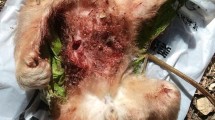Abstract
The male leadership of a troop of rhesus living at the foot of the Kumaon foothills of India was studied from January to December of 1965. The troop, inhabiting a region of fields and forests, varied in size from a maximum of 20 after the birth season to a minimum of 14 in December during the breeding season. The troop initially contained two adult males with the occasional presence of a third, more peripheral male. This third male disappeared in March and was perhaps identical with the male who began to appear in August and succeeded in displacing the dominant male from the troop. The second initial male succeeded to the dominant position in September. During the breeding season various extra-troop males followed and occasionally penetrated the troop. The second male had difficulty in maintaining his position against one of these, who had perhaps been the peripheral male at the beginning of 1965.
Similar content being viewed by others
References
Altmann, S. A., 1962. A field study of the sociobiology of rhesus monkeys,Macaca mulatta.Ann. N.Y. Acad. Sci., 102(2): 338–435.
Champion, H. G., 1936. A preliminary survey of the forest types of India and Burma.Indian Forest Records (Silviculture Series), vol. 1, no. 1.
Chance, M. R. A., 1956. Social structure of a colony ofMacaca mulatta.Brit. J. Anim. Behav., 4: 1–13.
——, 1963. The social bond of the primates.Primates, 4(4): 1–22.
Fisler, G. F., 1967. Nonbreeding activities of three adult males in a band of free-ranging rhesus monkeys.J. Mammal., 48(1): 70–78.
Hall, K. R. L. & I. DeVore, 1965. Baboon social behavior. In:Primate Behavior,I. DeVore (ed.) New York, pp. 53–110.
Jay, P., 1965. The common langur of North India. In:Primate Behavior,I. DeVore (ed.) New York, pp. 197–249.
Kaufmann, J. H., 1965. A three year study of mating behavior in a free-ranging band of rhesus monkeys.Ecol., 46: 500–512.
--, 1967. Social relations of adult males in a free-ranging band of rhesus monkeys. In:Social Communication among Primates,S. Altmann (ed.) Chicago, pp. 73–98.
Kummer, H., 1957. Sociales Verhalten einer Mantelpaviangruppe.Beih. Schweiz. Z. Psychol., 33: 1–91.
--, 1967. Tripartite relations in Hamadryas baboons. In:Social Communication among Primates,S. Altmann (ed.) Chicago, pp. 63–71.
—— &F. Kurt, 1963. Social units of a free-living population of Hamadryas baboons.Folia Primat., 1: 4–19.
-- & --, 1965. A comparison of social behavior in captive and wild Hamadryas baboons. In:The Baboon in Medical Research,H. Vagtborg (ed.) Austin, Texas, vol. 1, pp. 65–80.
Neville, M. K., 1966. A study of the free-ranging behavior of rhesus monkeys. Unpublished doctoral thesis, Harvard University, Dept. of Anthropology.
--, in press. Ecology and activity of Himalayan foothill rhesus monkeys (Macaca mulatta). Ecol.
Nishida, T., 1966. A sociological study of solitary male monkeys.Primates, 7(2): 141–204.
Rowell, T. E. &R. A. Hinde, 1962. Vocal communication by the rhesus monkey (Macaca mulatta).Proc. Zool. Soc. London, 138: 279–294.
Sugiyama, Y., 1965. On the social change of Hanuman langurs (Presbytis entellus) in their natural condition.Primates, 6(3–4): 381–418.
——, 1966. An artificial social change in a Hanuman langur troop.Primates, 7(1): 41–72.
--, 1967. Social organization of Hanuman langurs. In:Social Communication among Primates,S. Altmann (ed.) Chicago, pp. 221–236.
Author information
Authors and Affiliations
About this article
Cite this article
Neville, M.K. Male leadership change in a free-ranging troop of Indian rhesus monkeys (Macaca mulatta). Primates 9, 13–27 (1968). https://doi.org/10.1007/BF01795883
Received:
Issue Date:
DOI: https://doi.org/10.1007/BF01795883




